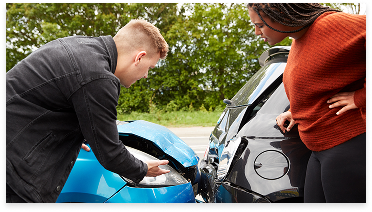
Uninsured Motorist Coverage
Get a quick uninsured motorist coverage quote online
Why Uninsured Motorist Coverage Matters
Auto accidents are stressful. When the at-fault driver lacks insurance, that stress quickly turns into financial risk for everyone involved. Standard car insurance policies don’t cover every scenario—particularly when damages are caused by uninsured or underinsured drivers. That’s why uninsured motorist (UM) coverage plays such an important role in a well-rounded auto policy.
Uninsured motorist coverage helps protect you against these gaps, covering medical expenses, lost wages, and more when the at-fault driver is unable to pay. It also applies in many hit-and-run cases, where the other driver is unknown and legally classified as “uninsured” in most states.
With nearly 1 in 8 drivers in the U.S. operating vehicles without insurance, UM coverage isn’t just recommended—it’s essential. Not sure if your current policy offers enough protection? InsureOne’s licensed agents provide a concierge experience to help you review and enhance your coverage with confidence.
How Much Does Uninsured Motorist Coverage Cost?
Uninsured and underinsured motorist coverage is generally one of the most affordable additions to an auto insurance policy. On average, it costs between $50 and $75 per year, depending on factors such as your location, driving record, vehicle type, and selected coverage limits.
Because UM/UIM is added to your existing policy, it’s typically more cost-effective than purchasing standalone protection.
Uninsured Motorist Coverage Options and Limits
Uninsured motorist coverage is typically split into two distinct categories, both of which can be customized to fit your needs:
| Coverage Type | What It Covers |
|---|---|
| UMBI (Uninsured Motorist Bodily Injury) | Medical bills, lost wages, and pain and suffering if you’re injured by an uninsured driver |
| UMPD (Uninsured Motorist Property Damage) | Damage to your vehicle caused by an uninsured driver or hit-and-run |
UM limits usually reflect your liability coverage amounts, unless you request different levels. In some states, UMPD may require a deductible.
Differences Between UM and UIM Coverage
Both uninsured (UM) and underinsured (UIM) motorist coverage serve the same goal: protecting you from drivers who cannot fully compensate you after an accident.
| Coverage Type | Who It Protects You From |
|---|---|
| UM | Drivers with no insurance at all |
| UIM | Drivers with too little insurance to cover your full costs |
In either case, your own insurance provider steps in to cover the difference between what you’re owed and what the other driver’s policy can pay. Having both UM and UIM coverage helps create a more comprehensive protection plan—especially important in states with low liability minimums or high rates of uninsured drivers.

What is the Difference Between Uninsured Motorist Coverage and Collision?
UM coverage and collision coverage are two distinct types of auto insurance, each serving a unique purpose.
Uninsured Motorist (UM) Coverage: This covers you if you’re involved in an accident with a driver who doesn’t have insurance or doesn’t have enough insurance to cover the damages. UM covers things like medical expenses, lost wages, and pain and suffering. It also applies if you’re hit by a hit-and-run driver since you can’t hold the at-fault driver accountable if they’re not identifiable.
Collision Coverage: This type of insurance helps pay for damages to your own vehicle when you’re at fault in an accident or if you’re involved in a crash with an identifiable driver. Collision coverage pays for the repair or replacement of your car, regardless of fault.
While Collision coverage effectively addresses vehicle repairs following an accident, it does not cover medical expenses or other costs incurred if you are involved in a collision with an uninsured or underinsured driver.
In such cases, uninsured motorist (UM) coverage is important because it provides an essential safeguard, ensuring protection not only for vehicle damage but also for medical expenses and other critical costs. This combination offers a more comprehensive safety net in the event of an accident with an uninsured driver.
How Can I Tell If My Policy Includes Uninsured Motorist Coverage?
To verify whether your current car insurance policy includes uninsured or underinsured motorist coverage, start by reviewing your declarations page—the document that outlines your coverage types, limits, and deductibles.
Look for terms like UMBI, UMPD, UIMBI, or UIMPD, which refer to bodily injury and property damage protection under uninsured or underinsured scenarios. These will typically be listed alongside your liability and comprehensive coverage details.
If you’re unsure how to interpret your policy, InsureOne’s licensed agents are here to help. We’ll walk you through your current coverage and identify opportunities to strengthen your protection—all while keeping your policy customized and cost-efficient.
Do I Really Need Uninsured and Underinsured Motorist Coverage?
While uninsured and underinsured motorist coverage isn’t mandatory in all states, it is required in 20 states, including Connecticut, Illinois, New York, and North Carolina.
Even if it’s not required where you live, it remains a highly valuable and cost-effective addition to your auto insurance policy. This (sometimes) optional auto coverage provides essential protection if you’re involved in an accident with a driver who lacks sufficient insurance to cover the damages.
In addition to helping with accident-related damages, it can also cover health-related expenses that your health insurance may not fully address, such as lost wages, deductibles, and injuries to passengers. With over 12% of drivers in the U.S. uninsured, it’s an important safeguard, especially in states with low liability minimums or high rates of hit-and-run incidents.
Uninsured and underinsured motorist coverage offers a customized layer of protection that ensures you’re not left covering someone else’s financial responsibility. It’s especially valuable if:
- You live in a state with a high rate of uninsured drivers.
- Your health insurance doesn’t fully cover post-accident costs.
- You want a concierge-level policy that prepares you for worst-case scenarios.
Do I Really Need Uninsured Motorist Coverage If I Have Health Insurance?
Health insurance alone may not offer the full protection needed after an accident—especially when the at-fault driver is uninsured. While your health plan may help cover immediate medical care, it often excludes critical costs such as:
- Lost wages during recovery
- Pain and suffering
- Passenger injuries
- Out-of-pocket medical expenses like deductibles and copays
Uninsured motorist coverage is designed to fill these gaps, providing broader financial support and faster access to benefits—particularly in hit-and-run situations or when delays from third-party insurers are likely.
For drivers who want to ensure they’re fully protected, why you need more than minimum coverage becomes clear. Adding uninsured motorist coverage is a proactive step to secure a more comprehensive and customized insurance plan.

Quick Steps to Secure Your UM Coverage with InsureOne
Protecting yourself against uninsured drivers starts with the right policy—and the right partner.
At InsureOne, our agents make it easy to compare quotes from top-rated insurers, explain your coverage options clearly, and build a policy that aligns with your needs and comfort level. Whether you’re seeking full protection or enhancing an existing plan, we’re here to simplify the process.
Add uninsured or underinsured motorist coverage to your auto insurance today—online, over the phone at (800) 836-2240, or by visiting one of our conveniently located offices.
Looking for more coverage? Ask about InsureOne’s Auto Club Maintenance Plan, which offers 24/7 roadside assistance and routine maintenance—so you’re covered even when it’s not an accident.


